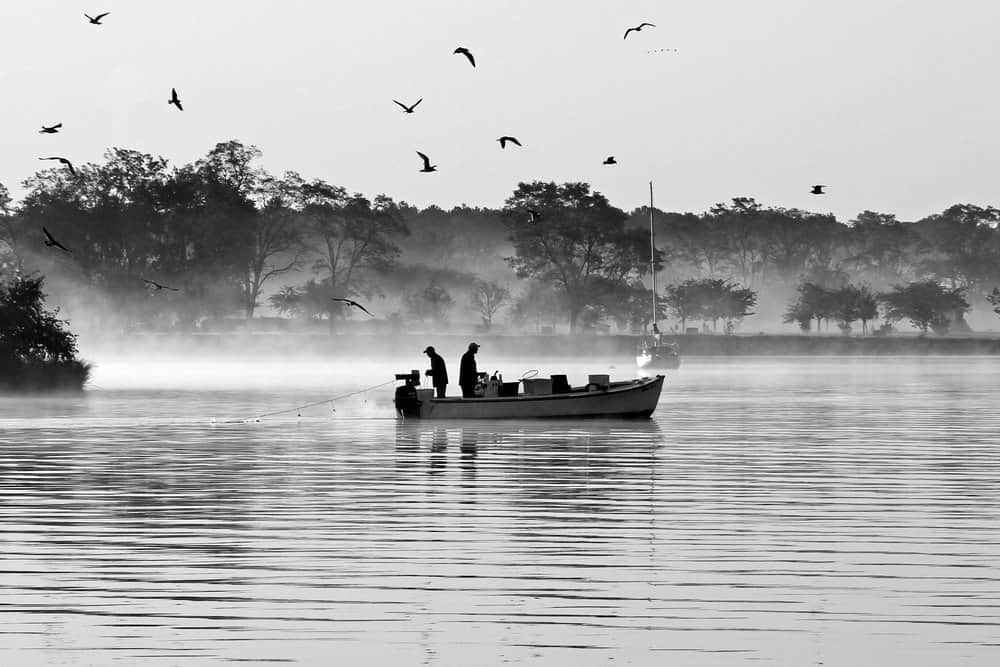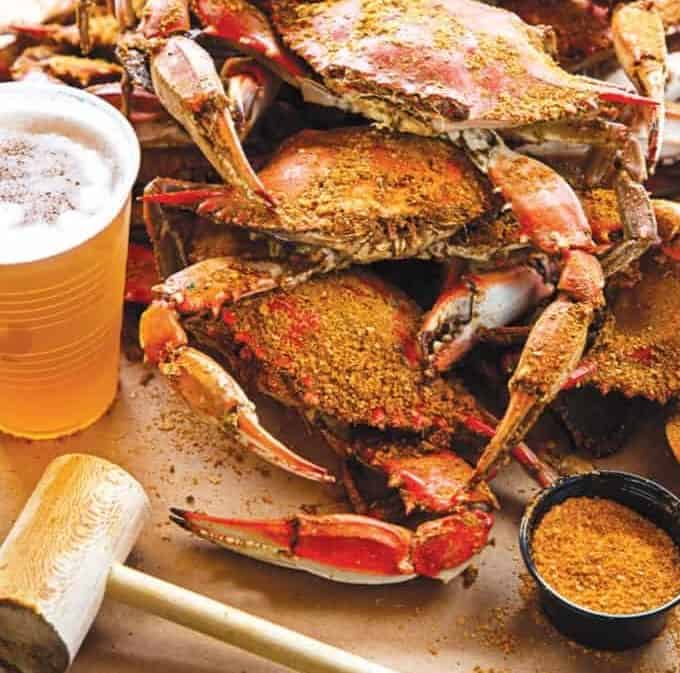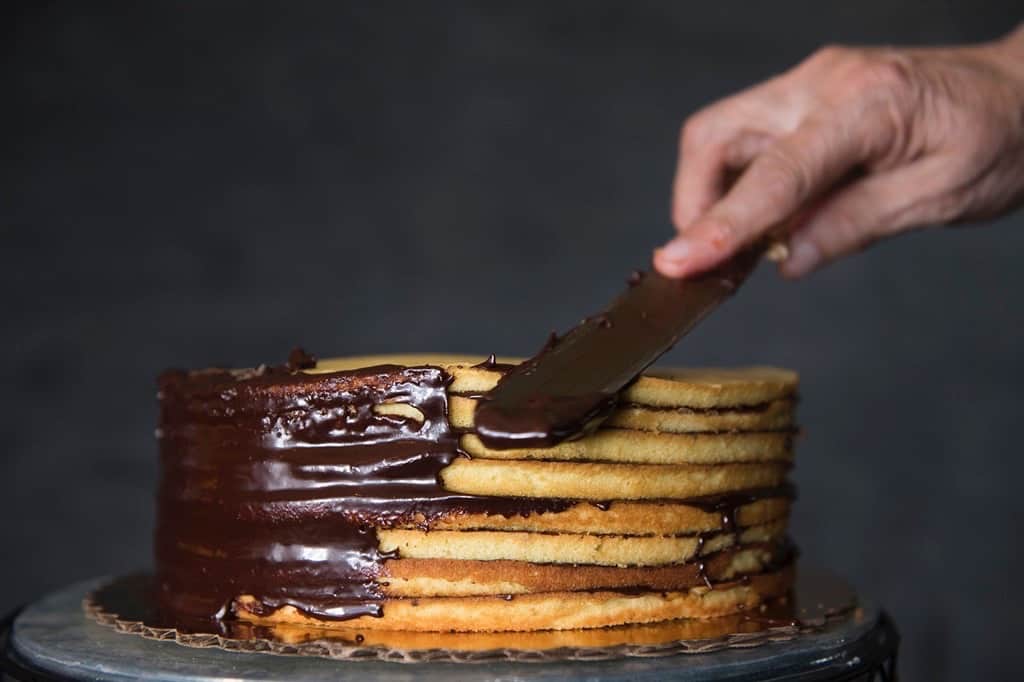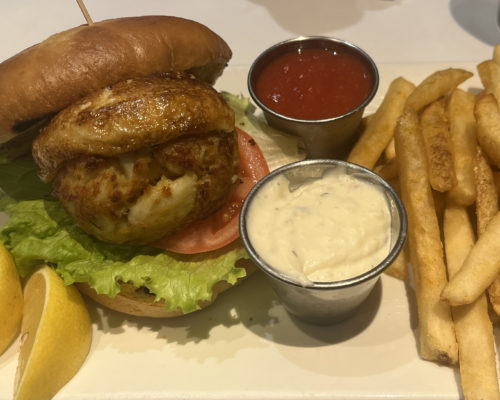Tips and techniques for enjoying blue crabs, the Bay’s tastiest pastime
It’s early one sweltering evening in 1977 as the sun begins to dip below the tree line. Beneath a patio light that’s under attack from a hundred buzzing insects, my father and I sit surrounded by 1,000 feet of braided nylon line, a couple of wooden bushel baskets, a 25-gallon tub of brine, and 30 pounds of very dead and extremely odiferous salted eels. My father sips a coffee-mug martini with a cigarette hanging off his lower lip and ties loops in the line while I dice up pieces of eel and slip them in the openings. By the time we finish baiting all 1,000 feet of line we collectively smell of brined eel, sweat and gin. Our legs are peppered with itchy red bumps inflicted by biting flies. My mother despised this routine. My father and I relished it.
While my teen years would render me too aloof and emotional for crabbing—cars, friends and romance were seemingly more important—for eight years, my pops and I ran that trotline together almost every summer weekend. I loved it. We woke well before dawn and trailered our fiberglass skiff and its cantankerous cohort, a 25-horse Evinrude two-stroke outboard that seldom worked, across the Bay Bridge to Eastern Bay. Dad drove the boat and I scooped up the crabs as they magically appeared out from the depths on our trotline. Once we had a bushel’s worth we made for home, steamed them up, and spent hours into the evening picking the sweet meat from their hard exoskeletons. These are among my best childhood memories—sunburn, smelly eels, mosquito bites and all.
Crabbing with traps, pots, a net, hand lines, or a trotline is something you simply do, or should do at least once, if you live in Chesapeake Country. But if snoods, bull lips, chicken necks, and jimmies and sooks all sound like Mandarin Chinese to you, never fear, you’ll get the scoop here with tips from a recreational crabbing sensei and a dose of my own experience. Before you know it you’ll be cracking open cold cans of suds over a pile of spicy steamed crabs. You’ll love it.
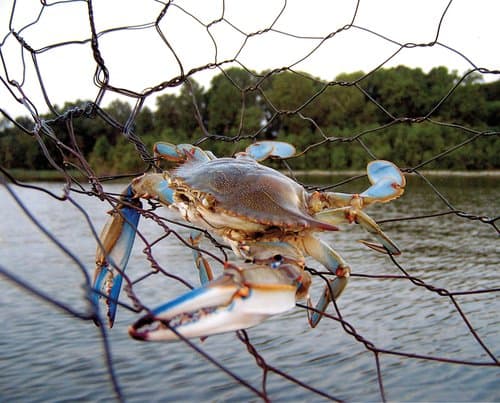
First Things First
The recreational and commercial crab fisheries in Maryland and Virginia are tightly regulated and enforced by Maryland Natural Resources and Virginia Marine police agencies. There are rules regarding how many crabs
you can take home, how large they must be, and restrictions on keeping certain sexes, as well as regulations regarding the type and quantity of gear you can use. Some gear requires licensing with the state, while hand-lining and dipping up crabs with a net generally do not require government entanglement. Instead of boring you with the extensive details—visit the Maryland (dnr.maryland.gov) and Virginia (www.mrc.virginia.gov) crabbing regulations pages online. Crabbing licenses for both states are available online or at most bait and tackle shops, which also generally have printed copies of fishing and crabbing regulations. Also learn up on how to tell a male (jimmy) from a female (sook) and from an immature female (she crab) so that you don’t inadvertently slip an illegal recruit into your catch basket.
Methods and Materials
There are all sorts of ways to rustle up a bunch of crabs for dinner, and owning a boat is not a prerequisite. Hand-lining—also affectionately known as chicken-necking—is the easiest way to get started. It’s also the most entertaining, in some respects. Hand-lining employs a 10- to 15-foot piece of cotton twine or masonry line with a chicken neck tied on the end. You can buy the necks and twine at your local tackle shop or hardware or grocery store. You’ll also need a crabbing net. My dad and I always had better luck with chicken-wire nets over ones made of nylon mesh, which crabs easily get tangled in. Wrestling an ornery, armored crustacean with weaponized claws out of cobweb of nylon netting is no fun. Other items to pick up include a bushel basket, a pair of heavy-duty crab tongs and a crab ruler.
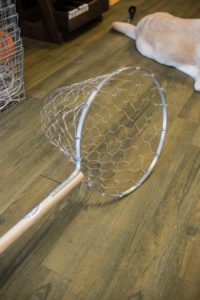
Once you’ve found a public dock, pier or bulkhead where crabbing is permitted, simply toss the baited lines out into the water—scattershot in different directions. When a blue crab is feasting on your offering, the line will begin to tighten and move; this is when you slowly and gingerly bring the line in hand over hand. Once the crab is in sight, simply scoop up the crab with the net. Getting the crab in the net before it darts off to safety is definitely more difficult than it sounds, but mastering this skill is half the fun. If the crabs are hungry, and your net game is good, it’s easy enough to bag a couple dozen for the steamer in an hour or two.
Traps are a popular way to catch some crabs and, like hand-lining, can be done from the dock—though most folks use them from a boat. There are three types: collapsible box traps, ring nets and pots. Collapsible box traps are made of galvanized or vinyl-coated wire and generally feature four sides with leader lines attached to a main line and a float. Some are shaped like triangles, some have tops, and some, called stackables, do not have tops, but they all catch blue crabs the same way. When deployed on the bottom, the trap’s sides fall open and crabs walk in to eat bait attached to the bottom of the trap. After the trap soaks for five to 10 minutes, you retrieve it with a swift pulling action, which closes the sides, trapping the crabs. A ring net trap works similarly but without collapsible sides. The netting expands when retrieved, trapping the crabs.
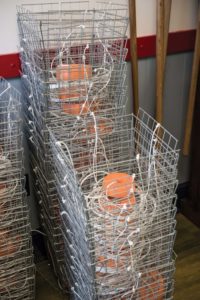
Crab pots are large, galvanized, chicken-wire cubes most often used commercially. In Maryland, recreational crab pot use is allowed only for waterfront property owners, and they are limited to the use of two pots, which must have turtle excluder devices and be registered annually. In Virginia, licensed recreational crabbers may use up to five crab pots.
In the basic crab pot, an interior compartment is loaded with fresh menhaden, razor clams or chicken necks, and the crabs sneak in via three or four circular openings to feed. By the time they’ve navigated the maze to the bait, they’re stuck and unable to get back out. Smaller cull rings in the pot allow smaller crabs to swim free. Most folks toss a baited pot or two off their docks and let them sit for a day or two before retrieving them and removing the crabs. Rebait, wash, rinse, repeat.
There’s no doubt you can catch plenty of crabs by hand-lining or employing traps or pots. But imagine if you had a 1,000-foot line with a piece of bait tied to it every six feet or so. Anchor it to the bottom at each end with a length of chain and an anchor marked by a float and you’ve got a trotline—a very effective method for catching crabs. The line is picked up at one end and then placed over a roller as the boat runs slowly along its length. Hungrier than they are intelligent, the ravenous blue crabs hang on aggressively for the ride to the surface where they can be scooped up by someone onboard who has some skill with a net. It’s one of the most enjoyable things you can legally do in a boat, if you ask me.
Essential trotline materials and other crabbing supplies such as traps, tongs, etc., can be ordered online. I’ve had great success from Captain Bruce’s Crabbing Supplies in North East, Md. There are also tutorials on the company’s website, www.stackablecrabtraps.com, where you can learn how to assemble your trotline.
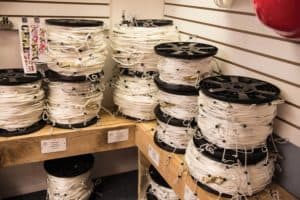
Instead of tying the baits directly to the trotline like my father and I did back in the bad old days, most folks today use a snooded trotline. Snoods made of bungee cord replace the traditional slip knots to hold the bait. A 1,000-foot trotline will have as many as 200 snoods. Some folks believe the springiness of the bungee helps smooth out the “ride” of the line so the crabs hang on longer. Some people think snoods are too labor intensive and cause the trotline to tangle easily. I’m a snood guy. I like the way a trotline runs with a little bit of a shock absorber between the crabs and the main line.
Trotlines require fiddling with to get right. Sometimes, after you’ve laid your trotline on the bottom, you’ll find the line too tight and other times too loose. Simply moving the anchor on one end to loosen or tighten the line will do the trick. You’ll figure out the right speed to run along the line as you go, and the learning curve for netting blue crabs is pretty easy. Generally speaking, when the line goes down, there’s something worth netting hanging on the line ahead; be ready for it and enjoy the adrenaline rush. Sometimes, lucky crabbers will find two crabs hanging on one bait. You’ve got good karma if they’re both keepers.
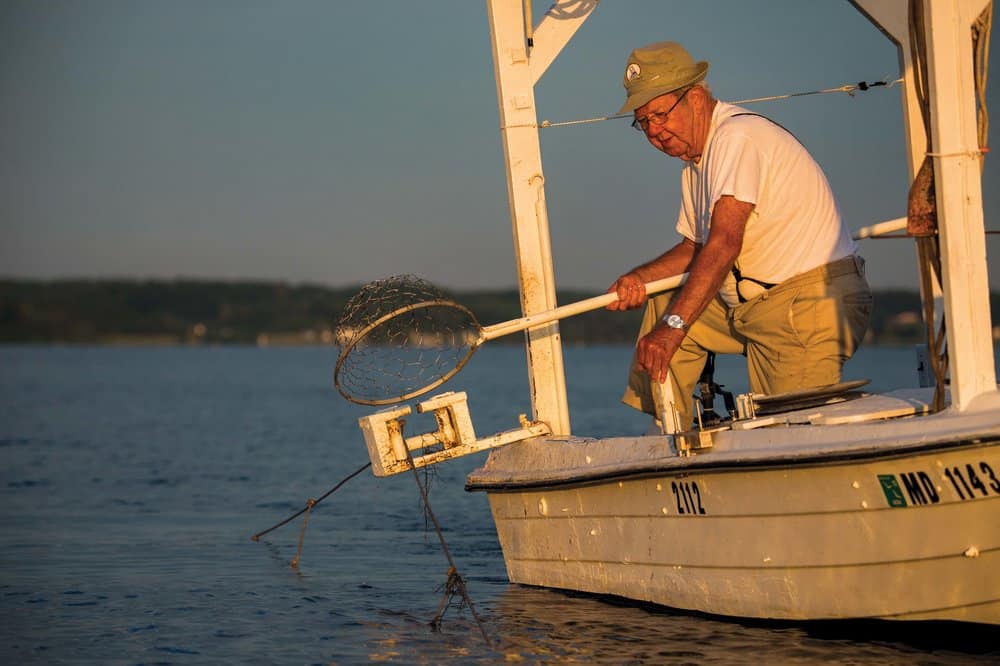
JAY FLEMING
Tips, Tactics, & Techniques for Blue Crabs
To get an idea of when to crab, where to do it, and what type of bait to use, I enlisted the help of Maryland’s resident recreational crab Jedi Jim Livingston. He’s been crabbing all over the Bay for 40-plus years, but it was during the last 13 seasons when he honed his craft to a sharp edge. You can find him crabbing most every weekend in his secret spot off the West River.
When I arrived at his Churchton, Md., house he was at his kitchen island with two laptops open. He was carefully eyeing dozens of pages’ worth of spreadsheet data from each of his crabbing excursions since 2004. “I put a thermometer on one or more of my traps and keep track of the temperature, as well as the date, time I crabbed, bait I used, and how many crabs I caught,” Livingston said. “I’ve got pages and pages of it.”
Using the data mined from his spreadsheets, Livingston tells me he’s catching crabs as early as the first week of June. “Early season is when I mainly use my traps. I can get them down into deeper water where the crabs are and they don’t have to use much energy to crawl into them. They’re sluggish that time of year. The trotline works better when they’re feistier. But I can definitely tell you they’re moving around when water temps are in the mid 50s,” he says. “By late June I’m running my trotlines, as well as traps. Last year, I crabbed well into the second week of November and caught some beautiful crabs. Most folks have given up by then.”
I asked him what the best depths for running a trotline or traps are for his neck of the woods. He said, “I catch most of my crabs between six and eight feet and I vary where I drop traps sometimes, but I like to run my trotline across the mouth of a gut in the creek. They seem to like it there. But I always experiment and move things around if the crabbing is slow.”
Proving that you don’t need a fancy boat to catch crabs, Livingston runs his traps and trotline from a 13-foot Gheenoe, a sort of canoe/johnboat hybrid with a three-horsepower, two-stroke outboard on its stern. He loads the slender boat high with gear, much like the big red crab boats stack their pots on the popular television series Deadliest Catch. Awake an hour before sunrise, Livingston baits his line, loads up the boat and heads out.
As for bait, Livingston uses the gamut available to him. He says, “If I can get razor clams they’re my preferred bait. It’s like, well . . . crack for crabs. They just give off an oily scent that crabs can’t resist. I put a few in each mesh bag (available from tackle shops and online suppliers) and attach them to my traps or trotline snoods. Chicken necks always work well and are more readily available, but they must be fresh. I also use chicken legs if they’re on sale and cheap. I know other guys who use bull lips, but I can’t see the value in them. They’re hard to find and I don’t think they work that well, but that’s just me.”
Livingston’s active on the online crabbing forums on Tidal Fish (tidalfish.com) where he goes under the handle “crabbermanjl.” His posts are a great way to get the intel on what crabs are doing. “I don’t share too much, but I’ll let folks know what’s happening. Some people won’t start until they see I’ve gone out and been successful,” he says. And Livingston doesn’t let all those crabs he catches go to waste. As I pack up to go, he hands me a pack of frozen crabmeat from the last season, a truly sincere and kind gesture. He’ll be glad to know that I cooked it up in a mean batch of Maryland vegetable crab soup.
Speaking of cooking, if you plan on keeping crabs and picking them at home (why else go crabbing?) get yourself a two-part steamer. Water, Old Bay and a can of beer go in the bottom. I also like to add vinegar. Some folks don’t. The crabs, dosed heavily with Old Bay or J.O. seasonings, go in the top pan. You can certainly cook crabs on your stovetop, but I bought a 15,000-BTU propane burner setup fairly cheap online. You can also use one to deep-fry turkeys. It gets the water boiling quickly and it keeps the operation outside. I like the smell of steamed blue crabs, beer and Old Bay in my house. My spouse does not. Problem solved.
Most everything else you need to know about crabbing can be acquired—like most things—by putting in time on the water, making mistakes, and then improving on them. My dad hurled dozens of emphatic curse words across Prospect Bay our first trip out. Within a month or two we were operating like a finely tuned machine, bringing home a bushel or more with each trip. I miss every minute of it.

